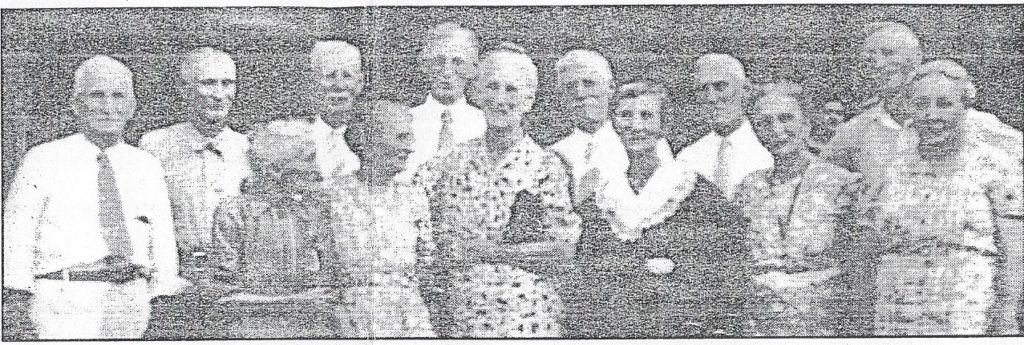By Regina Villiers. Originally published April 16, 1997 in The Suburban Life, added April 14, 2016.

A pre-1941 photo of 13 of the 17 children of William and Synthelia (Cely) DeMar. Longevity runs in the DeMar family, and all 13 lived to be in their 80’s and 90’s, and one, James, lived to be 102. From left are: (front row): Ann Marie Denman, Sallie Chamberlain, Jennie Stevens, Emma Armstrong, Elizabeth (“Lib”) Heltmeyer, Clara Symington, (back row): Joseph Frank, Will, James, Isaac, John, Clint, and Clyde DeMar.

Zachary Taylor DeMar became a legend in Madeira for his teaching and his leadership in Madeira’s schools.
(This is the first of a three-column series on the DeMar family.)
Somewhere near the top of its list of founding fathers, just behind the Hosbrooks and the Joneses, Madeira ranks the name, “DeMar.” But to stake a claim to that name, Madeira has to spar a bit with Indian Hill.
It’s true that the DeMars first settled in the area that is now Indian Hill, and that DeMar Road in Indian Hill is named for the family.
But it’s also true that the DeMar family spilled over into Madeira and became one of Madeira’s earliest founding families, actually helping to build its buildings, since many of them were carpenters.
James and Jane Rawlings DeMar started it all by coming here from Maryland in 1828. It’s believed that they came here through the influence of friends, the John Jones family.
The Jones family, one of the first two to settle here, had settled in Madeira in the late 1700s. It’s also believed that when the DeMars first arrived here, they stayed for a time with the Joneses, who lived in the area near the present Kenwood Country Club.
James and Jane DeMar built their first home at a spot that is now the northeast corner of Miami and Graves roads. It was a two-room log cabin, with a loft. This was the first unit of their home there.
They had 10 children and their house grew and grew with the years and the addition of children. The yellow, wooden, frame house still stands today.
One of their 10 children, their youngest son, Zachary Taylor, lived in that house all his life, 98 years. He married Anna Rutledge Clason, a teacher. They had three children- Lucy, Vida, and Clason. Lucy and Vida both teachers, lived on in the house after the deaths of their parents.
In all of Madeira’s history, it’s hard to find a more colorful character than Zachary Taylor DeMar. He even had a colorful name, so named because he was born in the year Zachary Taylor was elected president, 1848.
Commonly known as “Z.T.,” he became a legend in Madeira as a teacher, and he began the road to excellence for Madeira Schools.
He started teaching in Madeira in 1885, when he was 37 years old. He taught here until 1921, retiring when he was 73. He lived to be 98.
His school stood at the southwest corner of Miami and Camargo. It was a handsome, two-story, brick building built in 1875. There were two large rooms on the first floor for grades one through five, and one large room on the second floor for grades six through eight.
Z.T. taught grades six through eight. He would walk to school every day from his home at Graves and Miami roads, a long walk.
Three of DeMar’s former students-Ruth Butcher, Gus Uebel, and Oscar Meyer-all in their 90’s now, remember their teacher fondly. They remember him as one who ruled with a firm hand, but they also remember him as a teacher who allowed them to enjoy school.
Most of all, they remember that they learned in his school, and we should never forget his contribution to the reputation and the quality of our schools today.
Three older brothers of Z.T., sons of James and Jane DeMar, enlisted in the Union Army during the Civil War. Isaac was killed and buried in Birmingham, Ala. John was wounded and returned home to die. He is buried at Armstrong Chapel Cemetery.
The oldest son, William, did the most to populate the area with DeMars. He married Synthelia (Cely) Hetzler, and they had 17 children. Two of the children died in infancy. One, known only as “Little Babe,” lived only one month. Another lived to be 10 months old. Still another lived to be 14.
But the other 14 children all lived to adulthood. One of the 14 adults died at 41. But 12 of them lived to be in their 80’s and 90’s, and one lived to be 102.
Sallie and Elizabeth became widely known for being the oldest twins at meetings of the Buckeye Twins and the International Twins Associations. Sallie made it to 92 and Elizabeth live to be 95.
And all of this happened before we knew about cholesterol.
Three of the 17 children of William and Cely became important to Madeira. The stories of James Thomas, Clinton, and Clyde DeMar will continue in the next column.